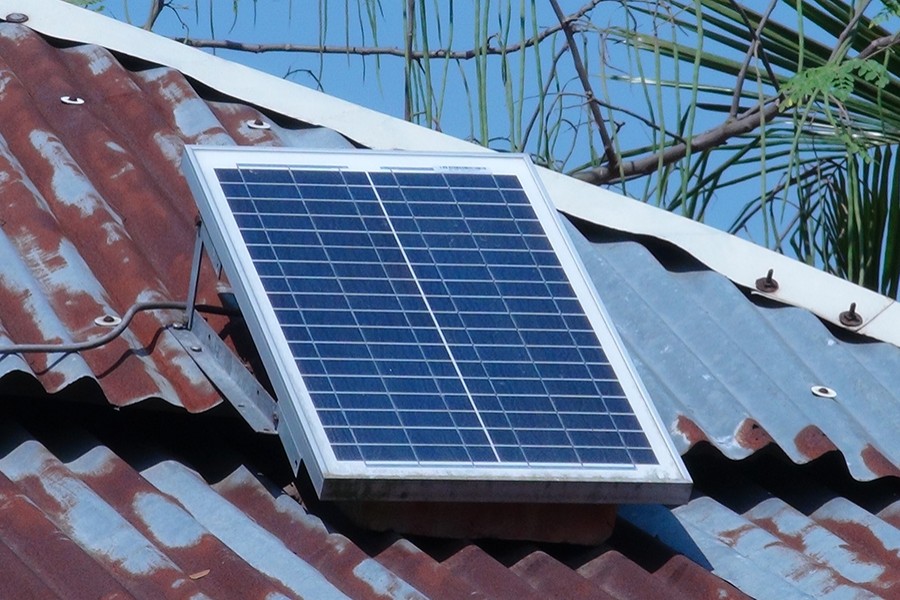Rural households in Bangladesh are witnessing a letup in solar power use because of higher maintenance costs of solar home systems (SHSs) and expansion of the national grid.
The FE correspondent has found that many of the houses in rural and coastal areas are facing difficulties with keeping their solar panels operational after expiry of the battery life.
The reason is that the battery replacement involves extra costs which they cannot afford.
On the other hand, many of the villagers have lost their interest in solar power use, as they have access to the national grid that has made the power supply cheaper and easier.
The power supply from the national grid is cheaper than the supply from the SHSs that necessitate replacement of the battery after a certain period.
Some of the villagers in the coastal area got their SHS free-of-cost under the KABITA/TR programme of the Ministry of Disaster Management and Relief. Others installed the solar panels with financial support from the government at a low rate of interest.
The Infrastructure Development Company Limited (IDCOL), a government-owned non-banking financial institution, has stopped providing its loans for SHS installation, as the ministry has been conducting the KABITA/TR programme for the last three years.
According to IDCOL, there are about 5.1 million SHSs installed in the country since 2013. Of them, the company has financed installation of about 4.1 million units and the government provided about 1.0 million free of cost.

During a visit to a village in Chandpur district, this correspondent found that a number of villagers had stopped using SHSs. After expiry of the batteries the villagers found it not cost-effective to replace them.
Moktar Mia, who purchased such a device from Grameenshakti, said he was not willing to buy the replacement battery for his solar panel as no loan was available for it.
"I have purchased the panel with a loan and repaid the amount. That time the supply from the national grid was not available here," he said.
Many of the houses that have electronic devices need higher-capacity electricity that the SHSs cannot meet.
According to the data available with the Sustainable and Renewable Energy Development Authority (SREDA), the number of SHSs declined to 238,316 in the calendar year 2019 from 320,297 in 2018.
In 2016, there had been around 721,922 SHSs installed in the country.
Salima Jahan, member (renewable energy) of SREDA, acknowledged that the SHS use declined recently.
She said the battery replacement for a set of SHS comprises almost 60 to 66 per cent of the cost. The rural people who got the panels free of cost may not afford this.
"The SHS usually generates very low-capacity power-20 to 120 megawatts and that also may be insufficient, as most of the people in rural areas have electronic devices," she said.
With an increase in the per capita income, the people in rural areas have the capacity to purchase television sets, refrigerators, mobile phones, etc., she added.
Md Enamul Karim Pavel, IDCOL head of renewable energy, said the demand from households sagged and it compelled the institution to shift its focus to other areas like solar irrigation system, street lights and roof-top solar panels for industries.
"Until 2016, the IDCOL provided Tk 45 billion in funding support at the 6.0 per cent rate of interest to encourage use of SHSs," he said.
The IDCOL had extended the support to the off-grid areas. But with the increase in power production, such areas declined significantly, he added.
Responding to a query about maintenance of SHSs after installation, he said the IDCOL placed a proposal requesting the government to consider loans for the users of SHSs so that they can purchase replacement batteries.
Solaiman Parsee Faisal, a resident in Panchani village of Matlab in Chandpur district, said he used to spend Tk 220 to 250 per month for his solar panel.
However, after expiry of the panel's battery life, he turned to power from the national grid which is cheaper.
According to the Economic Review-2019, the power generation hit its peak of 11,623 MW until February, 2019. In the fiscal year (FY) 2016-17, the country produced highest 9,479 MW of electricity.
Currently, the total power transmission lines account for 502,000 kilometres and the number of subscribers 32.7 million.
The government framed its renewable energy policy and made it effective from 2009.
About 572.63 MW of power has been produced from renewable sources so far, according to the Economic review.
In the seventh five-year plan, the government has set a target to generate 15 per cent of the total power consumption from renewable sources by 2021.


